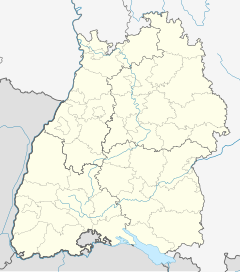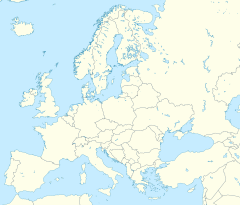Plochingen station
Plochingen station is the only station in the town of Plochingen in the German state of Baden-Württemberg and the most important railway junction of the Esslingen district. It is located 22.8 kilometres from Stuttgart Hauptbahnhof on the Fils Valley Railway and at the beginning of the Plochingen–Immendingen railway.
History
[edit]In the planning of the Fils Valley Railway (German: Filstalbahn) from Stuttgart to Ulm the chief engineer Michael Knoll foresaw a station southeast of Plochingen. At that time, approximately 1,900 people lived in the market town and its vineyards. On 14 December 1846, the Royal Württemberg State Railways (Königlich Württembergische Staats-Eisenbahnen) officially opened the Esslingen–Plochingen line. The completion of the next section to Süßen took place on 11 October 1847.[4] The first station building, which no longer exists, was a two-storey sandstone building. In 1852, a second track was completed on the Fils Valley line from Cannstatt to Plochingen. On 20 September 1859, the station became a junction station with the opening of the line then called the Upper Neckar Railway (Oberen Neckarbahn) to Tübingen.
In 1900, the Royal Württemberg State Railways planned to build a railway on the south bank of the Neckar from Stuttgart to Plochingen to relieve the Fils Valley line of the transport of freight. The planners revised their concepts several times. In 1909, they decided that the line should end in Esslingen, but this variant was not realised and the plan was abandoned. Proposals for a railway link between Neuhausen and Plochingen were rejected by the State Railways.
The growth of rail traffic made an extension of the railway facilities inevitable. These included the laying of many new tracks, the widening of platforms, the installation of new signal boxes and the inauguration of a new roundhouse and water tower. The current station building was built in 1905–1907 to a design by the famous architect Theodor Fischer in the Art Nouveau style.[5] The workers' houses along the line were built to his plans.
On 1 June 1913, Plochingen suffered major damage from a tornado and the station was affected, particularly the platform canopies.
On 1 June 1933, the line between Stuttgart and Ulm was electrified. This linked Plochingen for the first time with the Stuttgart suburban railway services—most services from Stuttgart, however, ended in Esslingen.
Because of the dense traffic on the line and the planned Stuttgart S-Bahn, Deutsche Bundesbahn rebuilt the Esslingen–Plochingen line as four tracks. This was completed on 27 September 1970; the related upgrading of the station lasted until 1974.
The first S-Bahn line, S1 was launched to Plochingen on 1 October 1978. Plochingen took a major role in the S-Bahn, since a train depot is located there. As part of the construction, Deutsche Bundesbahn demolished the old roundhouse and the water tower.
Track layout
[edit]
Track 1 is adjacent to the entrance building. The through tracks, 3/4, 6/7 and 9/10, are on three central platforms, which are accessed by an underpass. In the south direction of the platform 9/10 is the bay platform 59. At the southern end of the middle platform (3/4) are two more bay platforms, tracks 52 and 53, which are only used as depot tracks. Tracks 2, 5 and 8 do not have platforms and therefore they are only used by trains running through the station without stopping. West of the platforms, there are several storage tracks for S-Bahn and freight trains. North of the station is a depot for the maintenance of electric multiple units of the Stuttgart S-Bahn. The central bus station is next to the entrance building.
Entrance building
[edit]The station building of 1907 is very spacious. In its symmetry, it differs from the traditional station buildings of Württemberg. It has a long central block with a two-storey central section with a hipped roof, and the two wings with different hipped roofs. While the eastern extension has four floors, its western counterpart has a fifth floor and a clock tower on the ridge of its copper roof. The total length of the building is 96 metres.
Rail services
[edit]The following services stop at Plochingen station in the 2023 timetable:
Long distance
[edit]| Line | Route | Frequency |
|---|---|---|
| IC 32 | Dortmund – Düsseldorf – Cologne – Bonn – Koblenz – Mainz – Mannheim – Heidelberg – Stuttgart – Plochingen – Ulm – Memmingen – Kempten – Oberstdorf | 1 train pair |
| IC 55 | Dresden – Leipzig – Halle – Magdeburg – Braunschweig – Hanover – Bielefeld – Dortmund – Hagen – Wuppertal – Cologne – Bonn – Koblenz – Mainz – Mannheim – Heidelberg – Stuttgart – Plochingen – Reutlingen – Tübingen | 1 train pair |
Regional services
[edit]| Line | Frequency | |
|---|---|---|
| RE 5 | Stuttgart – Esslingen – Plochingen – Göppingen – Geislingen – Ulm – Ravensburg – Friedrichshafen – Lindau-Reutin | 60 min |
| MEX 12 | (Mosbach) – Heilbronn – Stuttgart – Stuttgart-Bad Cannstatt – Esslingen – Plochingen – Wendlingen – Nürtingen – Metzingen – Reutlingen – Tübingen | 60 min |
| MEX 16 | Stuttgart – Stuttgart-Bad Cannstatt – Esslingen – Plochingen – Göppingen – Süßen – Geislingen (– Ulm) | 30 min (core route) 60 min (whole route) |
| MEX 18 | Osterburken – Stuttgart – Stuttgart-Bad Cannstatt – Esslingen – Plochingen – Wendlingen – Nürtingen – Metzingen – Reutlingen – Tübingen | 60 min |
S-Bahn
[edit]| Line | Route |
|---|---|
| S 1 | Kirchheim (Teck) – Wendlingen – Plochingen – Esslingen – Neckarpark – Bad Cannstatt – Hauptbahnhof – Schwabstraße – Vaihingen – Rohr – Böblingen – Herrenberg |
Notes
[edit]- ^ a b "Stationspreisliste 2025" [Station price list 2025] (PDF) (in German). DB Station&Service. 28 November 2024. Retrieved 5 December 2024.
- ^ "Abkürzungen der Betriebsstellen" (in German). bahnseite.de. Retrieved 18 March 2011.
- ^ "Tarifzoneneinteilung" (PDF). Verkehrs- und Tarifverbund Stuttgart. 1 April 2020. Retrieved 16 April 2020.
- ^ Andreas Räntzsch (1987). Stuttgart und seine Eisenbahnen. Die Entwicklung des Eisenbahnwesens im Raum Stuttgart (in German). Heidenheim: Verlag Uwe Siedentop. p. 425. ISBN 3-925887-03-2.
- ^ "Weitere Sehenswürdigkeiten im Stadtgebiet" (in German). City of Plochingen am Neckar. Retrieved 18 March 2011.
References
[edit]- Andreas M. Räntzsch (1987). Stuttgart und seine Eisenbahnen. Die Entwicklung des Eisenbahnwesens im Raum Stuttgart (in German). Heidenheim: Verlag Uwe Siedentop. ISBN 3-925887-03-2.
- Stefan Hammer, Ralf Arbogast (1987). Alte Bahnhöfe in Württemberg (in German). Stuttgart: Verlag K. Thienemann. ISBN 3-522-62560-9.
- Otto Wurster (1949). Stadt Plochingen (ed.). Heimatgeschichte Plochingen (in German). Schorndorfer: Verlag Richard.




